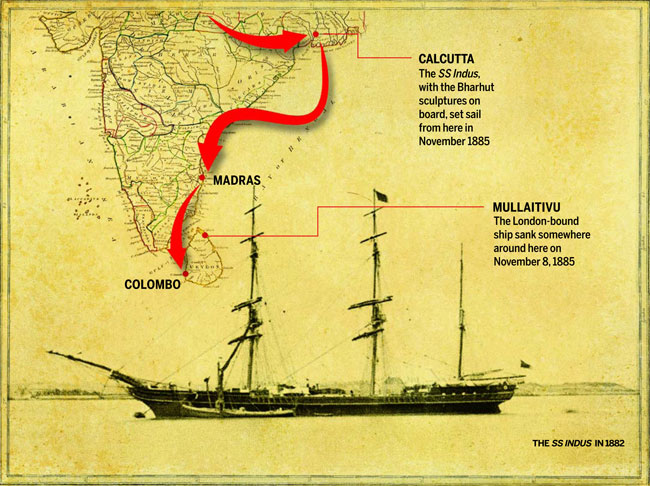Bharhut sculptures



This is a collection of articles archived for the excellence of their content. |
SS Indus: Kolkata
Anubhuti Vishnoi
December 18, 2014
Rare sculptures may be retrieved with breakthrough in tracing ship that sank in 1885
When the SS Indus set sail from Calcutta in November 1885, besides its wealth of indigo and chests full of Indian teas, it also had on board a little-known treasure trove-a collection of 3rd century BC sculptures put together by none other than the first head of the Archaeological Survey of India (ASI)-Sir Alexander Cunningham. The Bharhut sculptures, unearthed by Cunningham from a Buddhist monastery in Madhya Pradesh after rounds of excavations, were en route to London for an exhibition.
On November 8, 1885 the 3,462-tonne ship was steaming south from Madras to Colombo when she went aground at full speed owing to a navigational error. The SS Indus worked off the shoal at high tide and then came to rest on one of her own anchors that worked up a hole in the ship's bottom, sinking it within hours. There was no loss of life, but none of the cargo-including the prized sculptures and Cunningham's personal collection of coins-could be saved.
A century and quarter later, archaeologists from India and Sri Lanka are set to work together to retrieve the undersea treasure. This, after teams of Sri Lanka's Central Cultural Fund, Maritime Archaeology Unit (MAU) at Galle started scouring the country's northern coastline. In August 2013, a team led by Maritime Archaeology Research Officer S.M. Nandadasa finally zeroed in on what they believe is the wreck of the longsunken SS Indus near what was a Liberation Tigers of Tamil Eelam (LTTE) bastion, Mullaitivu.
ASI officials confirmed that an agreement with Sri Lanka to jointly retrieve the sculptures is in the works and the High Commissioner of Sri Lanka to India, Sudharshan Seneviratne, himself a professor of archaeology, is taking keen interest in the proposed joint venture. "Sri Lankan authorities wrote to us about having located the SS Indus. We are hopeful that the sculptures may finally be recovered. An MoU is being prepared for a joint underwater excavation and once the Ministry of External Affairs clears it, we hope to go ahead," ASI Additional Director General B.R. Mani, also a well-known archaeologist, told INDIA TODAY.
While all efforts to hunt down the SS Indus wreck site over the last century have been focused around Trincomalee-it was believed to lie on the seabed at 40 metres depth north of Trincomalee-the Sri Lankan authorities started looking around Mullaitivu after the end of the island nation's civil war in 2009, which allowed archaeological teams access to the erstwhile LTTE territory.
Nandadasa's report on the ship hunt has discarded the speculation that the wreck might be located "50 miles north of Trincomalee" and has pinpointed Mullaitivu instead. "Due to its age, the wreck must be in a fragile condition… it rests on a sandy bottom... The wreck is some two miles away from the location marked on the nautical chart… There is no other record of a similar ship being lost in this area," the report reads.
A carved reliefrailing in the Bharhut StyleBharhut is a historically significant site located in the Satna district of Madhya Pradesh. The ruins of the Bharhut Stupa-believed to have been built by Emperor Ashoka-still exist. The stupa dates back to the 3rd century BC while various works of art were added to the site in the Sunga period in the 2nd century BC. Bharhut represents the earliest or an iconic stage of Buddhist art when Lord Buddha was represented through symbols such as the Lotus and the Dharma Chakra, footprints, the Bodhi tree, and an empty throne. Predating the Sanchi Stupa and the Ajanta frescoes, Bharhut engravings also include inscriptions and narrative texts alongside panels.
While he first visited it in 1873, Cunningham excavated it the next year. He also took several structures and sculptures from Bharhut to what was then Calcutta, where they were housed in the Indian Museum. Little is known about the other remains of the Bharhut temple complex, which earlier also housed a massive statue of Buddha, ancient Sanskrit inscriptions and images of gods and goddesses. Speculation is that many of these sculptures were aboard the SS Indus when it sank.
A Peninsular & Oriental liner steam passenger ship, the SS Indus was built in 1871. The United Kingdom's National Maritime Museum records the ship as being docked in the London port at the time of the census of April 1881. "She had 17 Goan crewmen on board. She was wrecked off Ceylon in 1885; fortunately, no lives were lost," the museum records say.